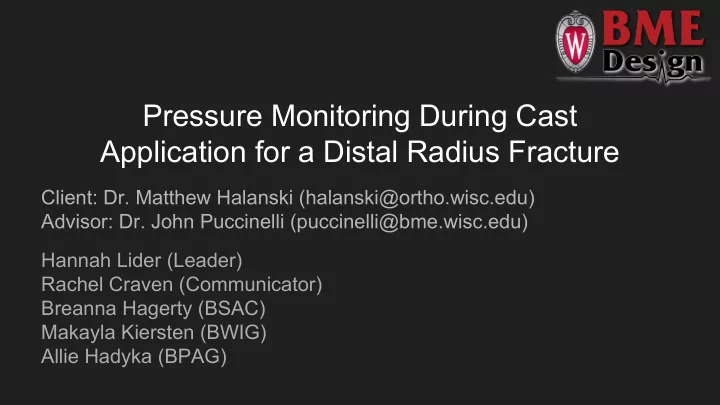

Pressure Monitoring During Cast Application for a Distal Radius Fracture Client: Dr. Matthew Halanski (halanski@ortho.wisc.edu) Advisor: Dr. John Puccinelli (puccinelli@bme.wisc.edu) Hannah Lider (Leader) Rachel Craven (Communicator) Breanna Hagerty (BSAC) Makayla Kiersten (BWIG) Allie Hadyka (BPAG)
Overview ● Introduction ● Pressure Sensor ○ Client Selection ○ Problem Statement ● Attachment Method ○ Background Selection ■ Current Methods ● Future Work and Models ● Acknowledgements & References
Client Description ● Dr. Matthew Halanski Pediatric orthopedic surgeon at ○ UW Hospital & Clinics ○ Research interest in safe immobilization and fracture reduction Matthew Halanski, MD http://www.thehartwellfoundation. com/2012/2012_Investigators.shtml
Problem Statement Casting is becoming a lost art in medicine, yet many children and adults need casts applied. While this appears to be a benign treatment, complications are known to exist in the placement and removal of these devices. Typically medical students and residents learn these techniques by trial and error. There is currently no method to sense pressures being applied as the bone is being set, or to sense the general pressure of the overall cast once applied.
Design Specifications ● Removable ● Ability to record pressure over time ● Real-time visible feedback of pressure change ● Sleek with limited protrusions ● Withstand casting procedures ● Expenses must be under $1,000
The Distal Radius Fracture ● Most commonly broken bone in the arm 40% of all pediatric fractures occur on the forearm 1 ● 75% of pediatric forearm fractures are distal 2 ● www.orthospinenews.com
Current Teaching Methods ● Trial and error ● Shadowing ● Sawbones Arm Model
Common Injuries ● Cast saw burns ● Skin abrasions and infection ● Improper bone healing Cast saw burns (courtesy of Dr. Halanski)
Past BME Design Work ● Spring 2013: BME 402 ○ Forearm fracture simulator ■ applied force, temperature at skin surface ● Spring 2014: BME 402 ○ pediatric fracture model Previous Fracture Model ■ temperature, surface pressure, BME 402 Spring 2014 bone alignment
FlexiForce Sensors ● Piezoresistive ● No resistance change when flexed ● Up to 445N ● 21.59cm length ● 9.53mm sensing area FlexiForce Sensor www.tekscan.com
Conductive Thread ● Carries a current ● Come in various resistances ● Can be used to create a circuit Sewn conductive thread circuit attached to LilyPad Arduino https://jrockdigitalart.wordpress.com/
Softpot Membrane Potentiometer ● Resistance range of 100Ω-10000Ω ● 215.86mm ● 4,064mm^2 sensing area ● Adhesive backing Softpot Membrane Potentiometer www.adafruit.com
Pressure Sensor Design Matrix Pressure Sensors Flexiforce Conductive Thread SoftPot Membrane Potentiometer Feel (25) (4/5) 20 (3/5) 15 (4/5) 20 Feasibility (20) (4/5) 16 (3/5) 12 (4/5) 16 Sensitivity (15) (5/5) 15 (5/5) 15 (4/5) 10 Durability (10) (4/5) 8 (4/5) 8 (4/5) 8 Safety (10) (5/5) 10 (5/5) 10 (5/5) 10 Fit (10) (4/5) 8 (5/5) 10 (3/5) 6 Accuracy (5) (4/5) 4 (2/5) 2 (3/5) 3 Cost (5) (3/5) 3 (5/5) 5 (4/5) 4 Total: 100 84/100 77/100 77/100
Compression Sleeve - Intact vs. Velcro ● Considerations ○ Fit ○ Ease of removability Professional Edema Sleeve www.pattersonmedical.com
Custom Sleeve - Intact vs Velcro ● Same considerations as compression style ● Customizable- fit and fabric ● More material variety ○ spandex, lycra blend ○ neoprene ○ piezoresistive fabric and conductive thread
Method of Attachment Design Matrix Compression Sleeve - Method of attachment Compression Sleeve Velcro Complete Custom Sleeve Custom Sleeve - Velcro Functionality (25) (2/5) 10 (4/5) 20 (3/5) 15 (4/5) 20 Bulkiness (20) (5/5) 20 (4/5) 16 (4/5) 16 (4/5) 16 Removability (20) (3/5) 12 (5/5) 20 (3/5) (5/5) 20 Feasibility (15) (5/5) 15 (4/5) 12 (2/5) 6 (3/5) 9 Durability (10) (4/5) 8 (4/5) 8 (3/5) 6 (3/5) 6 Safety (5) (5/5) 5 (5/5) 5 (5/5) 5 (5/5) 5 Cost (5) (5/5) 5 (5/5) 5 (4/5) 4 (4/5) 4 Aesthetics (5) (5/5) 5 (5/5) 5 (4/5) 4 (4/5) 4 Total: 100 80/100 91/100 68/100 84/100
LabVIEW Live Feedback ● 3D Sensor Mapping Express VI ● Import user-defined CAD model ● Assign sensors ● Map DAQ channel data directly onto model LabVIEW 3D Sensor Mapping Express VI http: //www.ni.com/white-paper/7335/en/#toc2
Future Work ● LabVIEW ● Circuit design ● Sleeve fabrication ○ Waterproofing
Acknowledgments Client: Dr. Halanski Advisor: Dr. Puccinelli
Questions?
References [1] Biomed Central. (October, 2010 30). Pattern of fractures across pediatric age groups: analysis of individual and lifestyle factors. Retrieved from http://www. biomedcentral.com/1471-2458/10/656 [2] Wright, M. (July, 2010 16). Forearm injuries and fractures. Retrieved from http: //patient.info/doctor/forearm-injuries-and-fractures
Recommend
More recommend